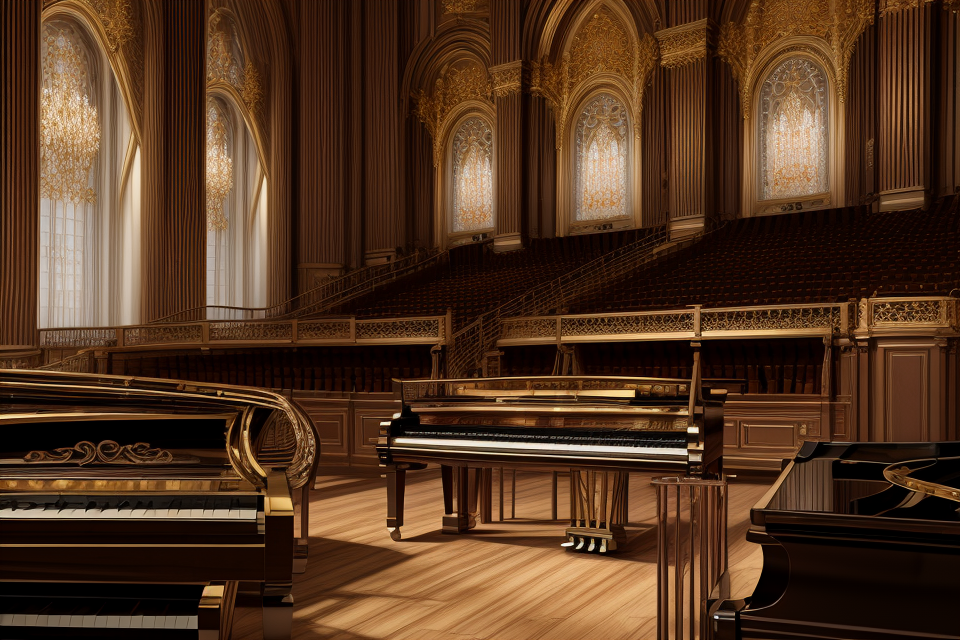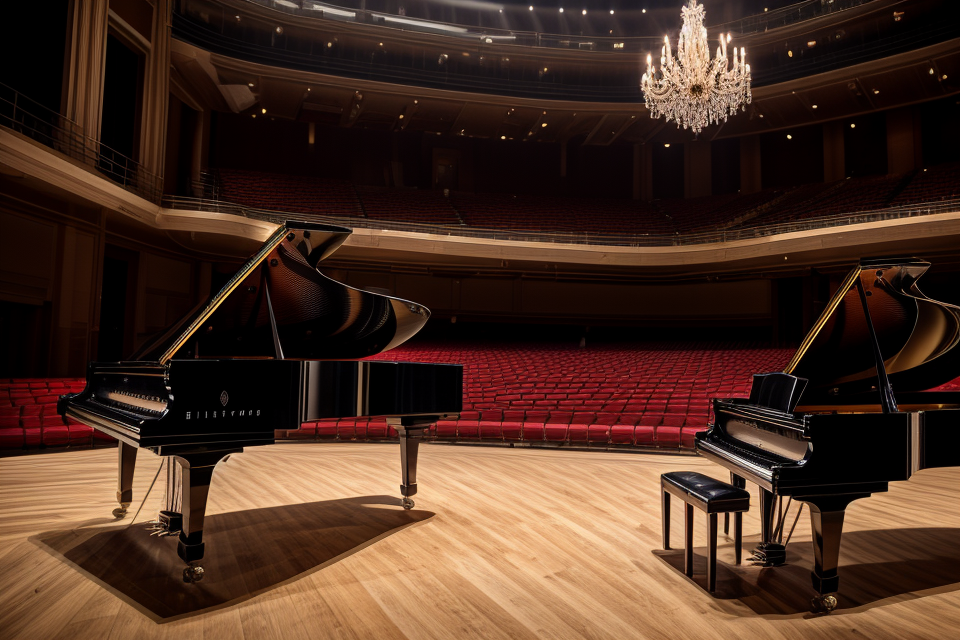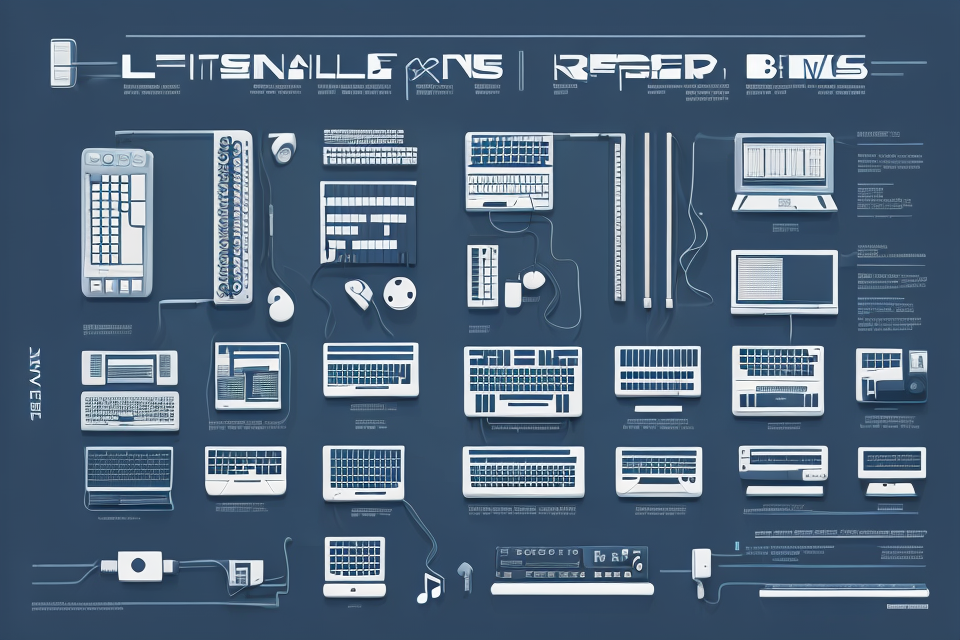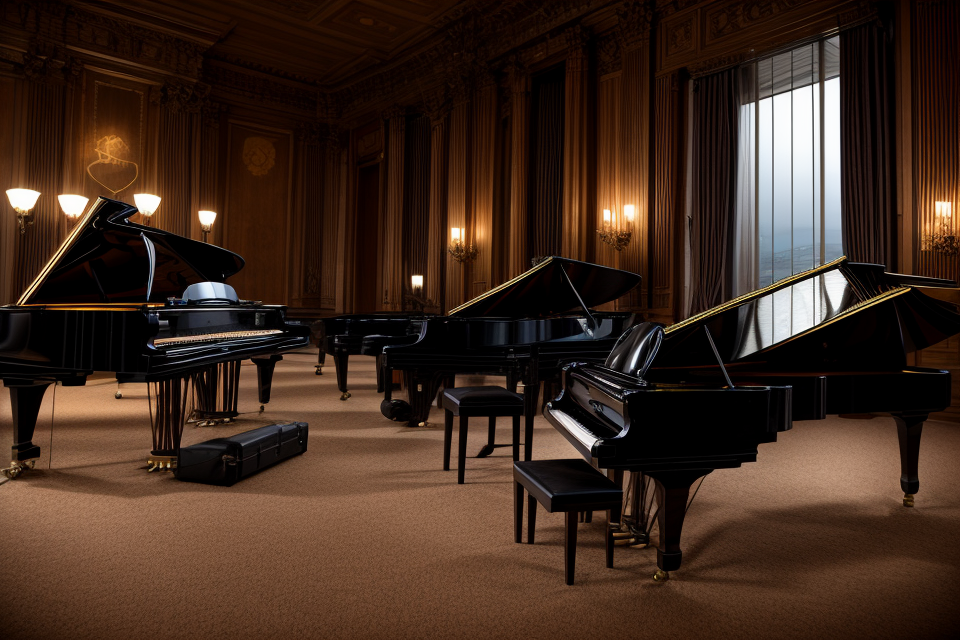The piano is often associated with classical music, but is it truly a type of classical music itself? This question has been debated among music enthusiasts for centuries. In this comprehensive guide, we will explore the connection between the piano and classical music, and delve into the history, evolution, and characteristics of both. We will examine how the piano has played a significant role in the development of classical music, and how its unique capabilities have allowed composers to create some of the most iconic pieces in the classical repertoire. So, whether you’re a seasoned musician or a curious beginner, join us as we uncover the fascinating relationship between the piano and classical music.
The Piano as a Classical Instrument
History of the Piano
Early Development of the Piano
The piano’s early development can be traced back to the early 18th century, when the first keyboard instruments were invented. These instruments, such as the clavichord and the harpsichord, were limited in their expressiveness and dynamics, which made it difficult for composers to convey a wide range of emotions and moods through their music.
Keyboard Instruments Prior to the Piano
Prior to the invention of the piano, keyboard instruments such as the clavichord and the harpsichord were used. The clavichord, which was invented in the late 14th century, was a very delicate instrument that produced sound by striking brass strings with small metal tangents. The harpsichord, which was invented in the early 15th century, was a more robust instrument that produced sound by plucking strings with quills or plectra.
The Piano’s Evolution
The piano’s evolution began in the late 18th century, when the Italian instrument maker Bartolomeo Cristofori invented the first piano. The piano’s design was influenced by the clavichord and the harpsichord, but it also incorporated some new features, such as a hammer mechanism that allowed the pianist to control the volume of each note. Over the years, the piano underwent many changes and improvements, including the development of the steel string, the pedal system, and the use of the “steel frame” which made it possible to make the piano larger and more powerful.
Piano as a Core Instrument of Classical Music
Classical Music Compositions for Piano
The piano has been a cornerstone of classical music for centuries, with composers such as Wolfgang Amadeus Mozart, Ludwig van Beethoven, and Frederic Chopin all creating iconic compositions for the instrument. From solo piano works to chamber music and orchestral pieces, the piano plays a central role in the classical music canon.
The Role of the Piano in Classical Music Performance
In addition to its prominence in composition, the piano also holds a significant place in classical music performance. Pianists are responsible for bringing these compositions to life on stage, and their skill and artistry are crucial to the success of any classical music performance. Pianists must possess a deep understanding of the instrument’s mechanics and technique, as well as the ability to interpret and convey the emotional depth of the music.
The Piano’s Impact on Classical Music
The piano has had a profound impact on classical music, shaping both its composition and performance. Its versatility and expressiveness have made it a favorite among composers, who have used it to explore new musical territories and push the boundaries of the genre. The piano’s dynamic range and ability to produce a wide variety of timbres have also allowed it to be used in a variety of settings, from the concert hall to the salon and beyond. As a result, the piano has become an integral part of the classical music tradition, and its influence can be heard in the music of composers across the centuries.
The Relationship Between Piano and Classical Music
Shared Elements Between Piano and Classical Music
Melody, Harmony, and Rhythm
The piano is an instrument that is deeply connected to classical music. It is capable of producing a wide range of melodies, harmonies, and rhythms that are integral to classical music. Classical music is known for its intricate melodies, which often feature complex harmonies and counterpoint. The piano is uniquely suited to play these melodies, as it has a wide range of keys and a rich, expressive sound.
Form and Structure
Classical music is often structured into specific forms, such as sonata form or symphony form. These forms typically involve a series of sections, each with its own distinct character and purpose. The piano is well-suited to play the various sections of these forms, as it can create a wide range of dynamics, textures, and moods.
Expression and Emotion
Classical music is known for its ability to evoke strong emotions in listeners. The piano is particularly well-suited to express a wide range of emotions, from the quietest subtleties to the most dramatic outbursts. Its dynamic range, combined with its ability to produce a wide range of timbres and colors, makes it an ideal instrument for conveying the complex emotions found in classical music.
In addition to these shared elements, the piano also has unique characteristics that make it an essential instrument in classical music. For example, its ability to play a wide range of dynamics and colors allows it to mimic the sound of other instruments, making it an ideal companion to orchestral music. Additionally, the piano’s built-in sustain pedal allows it to create long, sustained notes that are essential to many classical pieces.
Overall, the piano and classical music are inextricably linked. The piano’s unique capabilities, combined with its shared elements with classical music, make it an essential instrument in the world of classical music. Whether you are a beginner or an experienced musician, exploring the connection between piano and classical music is a journey that is sure to be both enriching and enjoyable.
Piano as a Tool for Classical Music Composition
Transcribing Classical Music for Piano
Transcribing classical music for piano involves the process of adapting a piece originally composed for another instrument or ensemble for the piano. This can involve rearranging the music to fit the piano’s unique layout and timbre, while maintaining the original composer’s intentions. Many classical composers, such as Johann Sebastian Bach and Wolfgang Amadeus Mozart, wrote piano transcriptions of their own works as well as those of other composers.
Adapting Classical Music for Piano
Adapting classical music for piano involves creating new arrangements or versions of existing pieces that are specifically designed for the piano. This can include changing the harmonies, melodies, or rhythms to better suit the instrument, or adding new elements such as improvisation or elaboration. Many classical composers, such as Franz Liszt and Frederic Chopin, were known for their piano adaptations of other composers’ works, as well as their own original compositions for the instrument.
Creating New Works for Piano within the Classical Tradition
Creating new works for piano within the classical tradition involves composing original pieces that adhere to the stylistic conventions and techniques of classical music. This can include sonatas, concertos, preludes, and other forms that are commonly associated with classical piano music. Many contemporary classical composers, such as Thomas Adès and Missy Mazzoli, continue to write music for the piano that builds on the rich tradition of classical music while also pushing the boundaries of the instrument’s capabilities.
Classical Music Genres and the Piano
Baroque Music and the Piano
Characteristics of Baroque Music
Baroque music is a style of Western classical music that emerged during the 17th and 18th centuries. This period saw the rise of many great composers, including Johann Sebastian Bach, George Frideric Handel, and Domenico Scarlatti. Baroque music is characterized by its complex counterpoint, ornate melodies, and dramatic dynamic contrasts.
Keyboard Music in the Baroque Era
Keyboard music played a significant role in the Baroque era. The harpsichord was the primary keyboard instrument during this time, and composers wrote numerous pieces for the instrument. However, as the piano began to gain popularity, composers started to write for the new instrument, and keyboard music began to evolve.
Piano Repertoire in the Baroque Style
Although the piano did not exist during the Baroque era, many composers wrote music that could be played on the piano in the Baroque style. These works often featured the same complex counterpoint and ornate melodies found in Baroque music. Composers such as Bach and Handel wrote piano music that showcased their mastery of counterpoint and their ability to create intricate harmonies.
Classical Music and the Piano
Characteristics of Classical Music
Classical music is a broad term that encompasses a wide range of musical styles and periods, from the late Baroque era to the early Romantic period. It is characterized by its complex structures, formal rigor, and emphasis on musical harmony and counterpoint. Classical music often features orchestral and choral works, as well as solo instrumental pieces, such as piano music.
Piano Repertoire in the Classical Style
The piano was invented in the late 18th century, and it quickly became a popular instrument for composing and performing classical music. Many of the most famous works of classical music, including sonatas, concertos, and chamber music, were written specifically for the piano. Piano music from the classical period often features complex technical demands, such as rapid scales and arpeggios, as well as a strong emphasis on musical structure and form.
The Piano’s Role in the Development of Classical Music
The piano played a significant role in the development of classical music. It allowed composers to explore new sounds and techniques, such as the use of dissonance and atonality, which helped to expand the boundaries of musical expression. The piano also facilitated the growth of the solo concert tradition, which allowed virtuoso performers to showcase their technical abilities and artistic interpretation. Additionally, the piano’s versatility as an instrument made it a popular choice for domestic entertainment, leading to the development of chamber music and other forms of domestic music-making.
Romantic Music and the Piano
Characteristics of Romantic Music
Romantic music, which emerged in the late 18th century and lasted until the mid-19th century, is a musical period that is characterized by its expressive and emotional nature. Romantic music often reflects the inner feelings and emotions of the composer, and is often associated with nature, love, and nationalism.
Piano Repertoire in the Romantic Style
The piano played a central role in the development of Romantic music. Many composers of the time, including Beethoven, Chopin, and Schumann, wrote extensively for the piano, and the instrument’s expressive capabilities were fully exploited during this period. Romantic piano repertoire includes a wide range of styles, from virtuosic showpieces to introspective character pieces.
The Piano’s Impact on Romantic Music
The piano had a profound impact on the development of Romantic music. Its ability to produce a wide range of timbres and dynamics allowed composers to explore new sound worlds and expressive possibilities. The piano also played a significant role in the development of piano technique, with composers such as Liszt and Rachmaninoff pushing the boundaries of what was possible on the instrument. Additionally, the piano’s portability and versatility made it an ideal instrument for the dissemination of music, allowing composers to reach a wider audience with their compositions.
The Piano in Contemporary Classical Music
Experimental Music and the Piano
Experimental music is a genre that pushes the boundaries of traditional music composition and performance. In recent years, the piano has played a significant role in the development of experimental music.
Electronic and Amplified Piano Techniques
One way that the piano has been used in experimental music is through the incorporation of electronic and amplified techniques. This includes the use of electronic devices to manipulate the sound of the piano, such as the use of pedals or the insertion of objects between the strings to create unusual timbres. Amplification of the piano has also been used to create new sounds, such as the use of contact microphones to capture the sound of the piano’s interior and exterior.
Prepared Piano and Extended Techniques
Another way that the piano has been used in experimental music is through the use of prepared piano and extended techniques. Prepared piano involves the manipulation of the piano’s instrumentation, such as placing objects on or between the strings to create unusual timbres. Extended techniques refer to non-traditional techniques used to produce sound on the piano, such as playing the strings inside the piano, using the keyboard as a percussion instrument, or playing the piano with the aid of other instruments or objects.
The Piano in Multimedia and Interdisciplinary Works
In addition to its use in experimental music, the piano has also played a significant role in multimedia and interdisciplinary works. This includes the use of the piano in combination with other instruments, electronic devices, or visual media to create a new form of music that transcends traditional boundaries.
Overall, the piano continues to be an essential instrument in contemporary classical music, with its versatility and range of sound making it an ideal choice for experimental and interdisciplinary works.
The Piano in Modern and Postmodern Music
Minimalism and the Piano
Minimalism, a musical movement that emerged in the mid-20th century, has had a profound impact on the role of the piano in contemporary classical music. Minimalist composers such as Steve Reich and Philip Glass often employ repetitive patterns and simple, evolving structures in their compositions, which place a greater emphasis on the rhythmic and harmonic elements of the music. This shift in focus has led to a renewed interest in the piano as a rhythmic instrument, with composers exploring new techniques for creating complex polyrhythms and textures.
The Piano in the Avant-Garde
In the avant-garde movement, composers have pushed the boundaries of traditional classical music, experimenting with new techniques and sounds. The piano has played a central role in this movement, with composers such as John Cage and Christian Wolff exploring new ways of playing and preparing the instrument. Cage’s famous work “Silence” (1952) highlights the importance of silence and stillness in music, while Wolff’s “For Piano” (1948) involves the performer manipulating the interior of the piano to create unconventional sounds.
The Piano in Contemporary Music
Contemporary classical music encompasses a wide range of styles and techniques, with the piano often playing a prominent role. Composers such as Kaija Saariaho and Osvaldo Golijov have written works that blend traditional classical forms with elements of jazz, electronic music, and world music, resulting in a diverse and innovative body of work. The piano has also played a key role in the development of new music technologies, with composers such as Paul Lansky and William Duckworth incorporating digital and electronic elements into their compositions.
In conclusion, the piano has been a central instrument in the development of modern and postmodern classical music, with composers exploring new techniques and sounds to push the boundaries of the instrument. Whether through minimalism, the avant-garde, or contemporary music, the piano continues to play a vital role in the evolution of classical music in the 20th and 21st centuries.
The Piano’s Enduring Legacy in Classical Music
The Piano’s Continued Relevance
The piano’s continued relevance in contemporary classical music cannot be overstated. Despite the evolution of technology and the introduction of new instruments, the piano remains an essential tool for composers and performers alike. Its versatility, expressiveness, and dynamic range make it an indispensable instrument in the classical music world.
The Piano’s Impact on the Evolution of Classical Music
The piano has had a profound impact on the evolution of classical music. Its invention in the early 18th century revolutionized the way music was composed and performed. Composers such as Wolfgang Amadeus Mozart and Ludwig van Beethoven wrote music specifically for the piano, and their works continue to be celebrated and performed today. The piano’s unique timbre and ability to produce a wide range of dynamics and colors have inspired countless composers to push the boundaries of classical music.
The Piano’s Universal Appeal
The piano’s universal appeal is another reason why it remains an important instrument in contemporary classical music. Unlike other instruments, the piano is accessible to people of all ages and backgrounds. Its standardized keyboard layout makes it easy to learn and play, and its affordability compared to other instruments makes it accessible to people of all income levels. Additionally, the piano’s rich history and cultural significance have made it a beloved instrument in many different cultures around the world.
FAQs
1. What is classical music?
Classical music refers to a broad range of musical styles that emerged in Europe during the 18th and 19th centuries. It encompasses various forms, including orchestral, chamber, and operatic music, as well as music for solo instruments such as the piano.
2. What is the piano?
The piano is a musical instrument that consists of a keyboard, strings, and a soundboard. It is played by pressing keys that trigger hammers to strike strings, producing sound. The piano is a versatile instrument that can be used to play a wide variety of musical styles, including classical music.
3. Is the piano a type of classical music?
Yes, the piano is a type of classical music. It was developed during the Classical period of music, which was a time of great innovation and experimentation in music. The piano became a popular instrument during this time, and many famous composers, such as Mozart and Beethoven, wrote music specifically for the piano.
4. What is the relationship between the piano and classical music?
The piano is an essential instrument in classical music, and it has been used by composers to create some of the most iconic and enduring works in the classical repertoire. The piano’s versatility and expressiveness make it an ideal instrument for composing classical music, and it continues to be an important part of the classical music tradition today.
5. Can other instruments be used to play classical music?
Yes, other instruments can be used to play classical music. However, the piano is often considered the ideal instrument for classical music due to its ability to produce a wide range of sounds and dynamics. Other instruments, such as the violin, cello, and flute, are also commonly used in classical music, but the piano remains an essential part of the classical music tradition.



